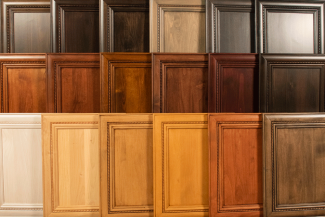

Either bristle or foam brushes will work well with Milk Paint and Top Coat. The folks at GF might use several types of brushes for a project.
For example:
Water-based products do not last forever, even when unopened. General Finishes products are best used within 1 year of the manufacture date listed on the bottom of the can. The life of the product may be extended to 2-3 years with proper care and storage.

Tint General Finishes Milk Paint Clear or White base to match colors in major manufacturer's paint decks using Colorfal Zero VOC water soluble colorants.
GF is rather conservative regarding the life of our Milk paint. Water based products do not last forever, even when unopened. General Finishes products are best used within 1-2 years.
Vinyl or paper veneers can be often found on the end returns of lower price-point cabinets. We cannot guarantee that our paints will adhere well to a paper veneer - we have no idea what the actual material is or what adhesives were used to apply the veneer to the surface. The resins and additives in our paints may break down the adhesives used for the veneer.
And Milk Paint does NOT adhere to vinyl.
General Finishes is proud and honored to be featured in the August 2015 issue of Woodworker's Journal. Michael Dresdner, a nationally known finishing expert, highlights the advantagous of GF water based products in his article (below
GF advises extra care and prep when applying any finish over laminate surfaces because they are specifically designed not to mar and therefore they are not very "sand-able", making adherence difficult.
In addition to this non-permeable surface factor, General Finishes Gel Stain is an oil-based product, and it is more difficult to obtain proper drying characteristics over a dense manufactured surface such as laminate. Gel stains, as all wood stains, were formulated to go over raw wood which has an "open" surface and can absorb some of the stain.

Now more than ever, water-based stains offer a viable alternative to oil-based and other solvent-based stains.
Water-based stains penetrate deeper into wood than oil-based stains, resulting in deep, rich colors in only one coat. Manufacturers, professionals, and DIY users moving away from solvent-based products to water-based systems find immediate advantages...
A primer is your best defense under light-colored paint.
Another technique to avoid the slight color change that sometimes occurs when applying topcoat is to add 10-15% of the paint you are using to your topcoat. This technique layers additional coats of color over your piece as well as providing the protection of a topcoat. If you don't like measuring, just add enough paint until you can see a bit of the hue in the topcoat. This method works with a brush or a spray gun.
To maintain the full-strength protection of the topcoat, DO NOT TINT YOUR FINAL COAT of topcoat.